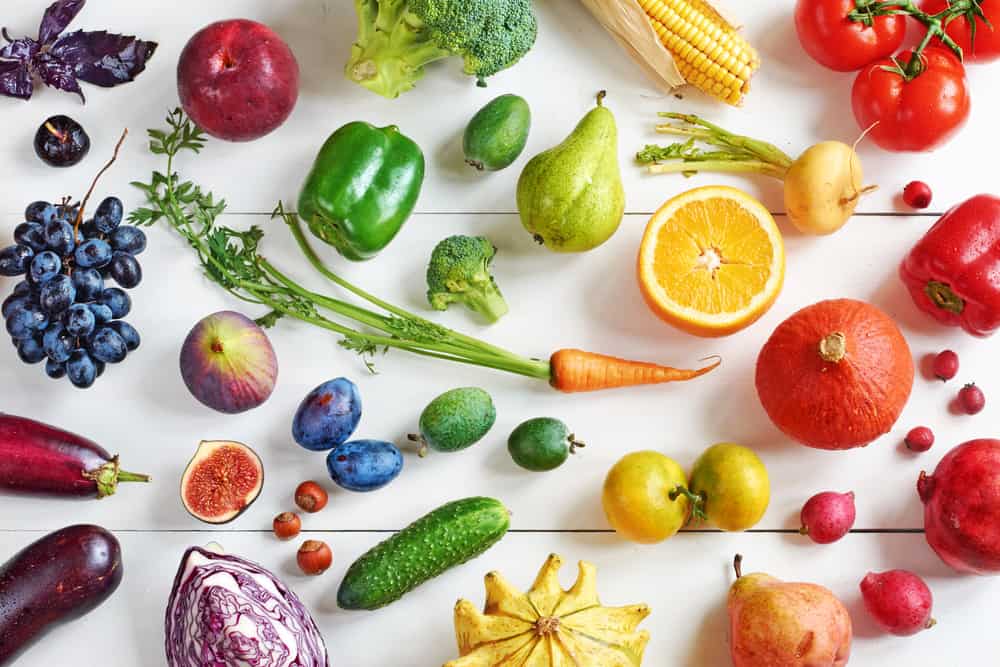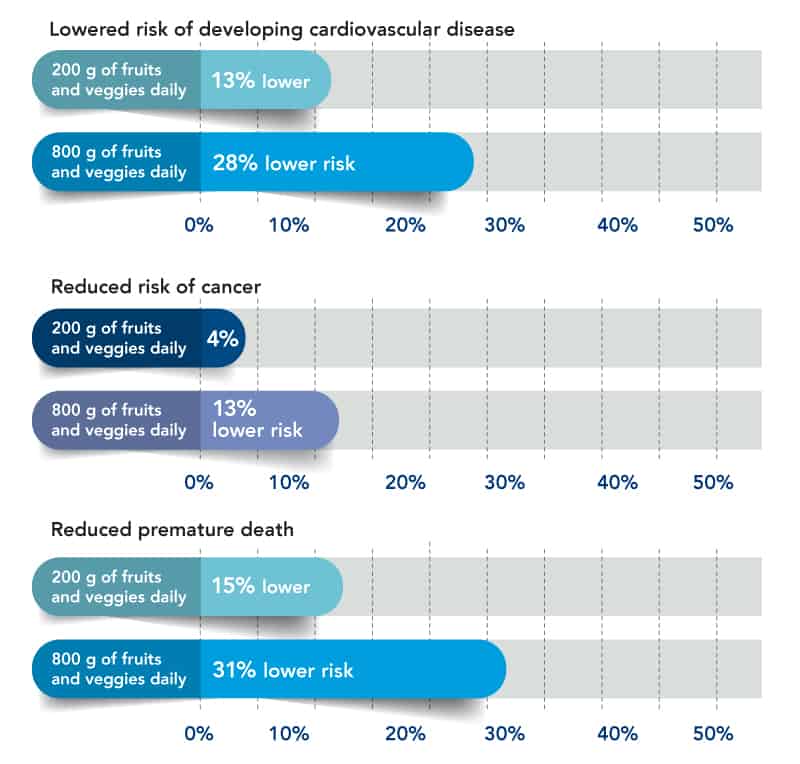Share this post
The healthy person’s guide to fruits and vegetables
If you ask the typical American how many servings of vegetables they eat per day, they’ll likely answer, “Not enough.” And they’re right; most of us aren’t getting enough of our plant-based foods or the nutrients they contain.
In their 2015-2020 Dietary Guidelines for Americans, theUnited States Department of Agriculture (USDA) recommends eating two cups offruit and two and a half cups of vegetables daily.[1] According to the their research, however, the average American adult consumesonly 1.1 cups of fruit and 1.6 cups of vegetables daily, putting us well belowthe target,[2] and increasing our risk for a host of diseases.
As compared to those who ate little to no fruits and vegetables, healthy eaters were found in one study to have significantly better health outcomes, including lower risks of developing cardiovascular disease, cancer, and premature death.
As compared to those who ate little to no fruits and vegetables, healthy eaters were found in one study to have significantly better health outcomes, including lower risks of developing cardiovascular disease, cancer, and premature death.
Here are the exact findings of this study:[3]
- Cardiovascular disease: Those who ate 200g of fruits and vegetables daily were at 13% lower risk of developing cardiovascular disease, while those who ate 800g per day cut their risk by 28%.
- Cancer: Eating fruits and vegetables daily reduced the risk of cancer by 4%, while eating 800g daily cut the risk by 13%.
- Premature death: A 15% reduction was seen in those who ate 200g of fruits and vegetables daily, and a 31% reduction in those who consumed 800g daily.
(To give you a sense of how many servings these people ate, it may help to know that a small banana weighs approximately 80g, and half a of bag of spinach leaves weighs 100g.)
These improved health outcomes resulting from the regular intake of fruits and vegetables are impossible to ignore. While there are many nutritional constituents making these foods smart, healthy choices, one particularly powerful mechanism by which fruits and vegetables fight disease is by their antioxidant function.
Understanding antioxidants
Oxygen is an element indispensable for life: without it, the mitochondria in our cells cannot produce energy (ATP). Oxygen, however, is a highly reactive atom, and thus emits a kind of “car exhaust” as a natural by product of its reactive metabolic processes. This “car exhaust” is known as reactive oxygen species or ROS, a type of free radical. (All ROS’ are free radicals, but not all free radicals are derived from oxygen.)
At certain levels, these free radicals damage healthy cell membranes and important organelles inside the cells, such as the nucleus and mitochondria, thus speeding up the aging process.
Other factors that increase cellular free radical production include:
- Inflammation
- Excessive exercise
- Stress
- Cigarette smoke
- Environmental pollutants, e.g. pesticides
- Radiation
- Dietary refined sugar and poor quality fats
Antioxidants are our defense against free radical damage and are critical for slowing down both the internal symptoms of aging (such as cardiovascular disease), as well as the external signs of aging (such as skin wrinkles).[4] At high concentrations, ROS and other free radicals can overwhelm the body’s natural antioxidant systems, compromising the important enzyme superoxide dismutase (SOD) and depleting the “master antioxidant”glutathione.[5]This results in something called oxidative stress, a deleterious process that damages cellular structure and function. Oxidative stress has been implicated in aging and poor health, as well as in the development of chronic and degenerative conditions such as cancer, arthritis, autoimmune disorders, cardiovascular diseases, and neurodegenerative conditions.[6]
Antioxidants are our defense against free radical damage and are critical for slowing down both the internal symptoms of aging (such as cardiovascular disease), as well as the external signs of aging (such as skin wrinkles).
Although we cannot stop the production of free radicals entirely, we can nevertheless minimize their production and maximize “damage control” by making simple yet powerful lifestyle changes. Getting antioxidants from the diet is an effective and easy way to protect our cells and tissues from excess free radical damage.[7]
Getting antioxidants from the diet is an effective and easy way to protect our cells and tissues from excess free radical damage.
Science has shown that we can protect ourselves from oxidative stress and reduce the aging process through lifestyle choices such as reducing refined sugar in the diet, reducing exposure to environmental toxins, managing stress, taking antioxidant supplements, and increasing our daily intake of fruits and vegetables.
Plant-based foods are rich in nutrients like the zinc and magnesium required for glutathione and SOD production. Fruits and vegetables also contain a range of different antioxidants and phytonutrients, like:
- Carotenoids like lutein and zeaxanthin. Found in yellow and green vegetables, carotenoids offer protection to the eyes, reducing the aging of retinal tissue in conditions like macular degeneration.[8]
- Flavonoids, such as the quercetin found in onions and apples, with their immune boosting effects.[9]
- Polyphenols, such as those found in in green tea and grape seed, which offer anti-aging benefits.[10]
Many fruits and vegetables are also high in vitamin C and vitamin E, offering yet more forms of antioxidant protection to the cells. In fact, studies show that vegetarian and vegan diets reduce the incidence of diseases linked to oxidative stress, likely due to their richness in antioxidants.[11]
In addition to food sources, antioxidants may also be taken in supplemental form, in formulas such as those containing the organic citrate forms of zinc and magnesium, vitamins C and E, and phytonutrients like lutein, zeaxanthin, and quercetin.
Speed of antioxidant functionality
But do all antioxidants work equally, or at the same pace? Research published in theJournal of Agricultural and Food Chemistry has shown how the antioxidant compounds found in lettuce leaves work at different speeds in the body, offering cellular protection over various timescales.[12]
The researchers used an imaging technique to watch the activity of antioxidant compounds in three types of lettuce leaves: the red colored ‘Oak leaf,’ the green and red ‘Marvel of four seasons’ and the green ‘Batavia.’ Whereas the red-leaved type had fast and intermediate antioxidant actions, the green and red type had fast, intermediate, and slow moving compounds. The green type contained intermediate and slow paced antioxidants.
Studies like this suggest that it’s important to include a range of different plants in the daily diet to not only to provide different types of antioxidants, but also to offer different speeds and coverage of antioxidant protection.
It’s important to include a range of different plants in the daily diet to not only to provide different types of antioxidants, but also to offer different speeds and coverage of antioxidant protection.
In other words, it’s not just the amount of plant matter we eat that makes a difference to our health, but also the type. That’s why it’s a good idea to eat a rainbow of different colored fruits and vegetables each and every, to provide the body with a vast array of antioxidant compounds.
Here are five easy ways to boost your daily vegetable intake:
- Use more varieties of vegetables that you usually would. For example, when cooking a casserole with onions and carrots, add in some fennel, tomatoes, and squash or sweet potato.
- Shred your veg! Use a food processor or mandolin to finely slice different colored cabbages, onions, and carrots to make a tasty homemade slaw. Smaller pieces of vegetables are easier to digest and you can eat more of them!
- Make a smoothie. Throw in a handful of spinach, a small banana, half an avocado, and a handful of frozen blueberries into a blender with some almond milk to pack a big dose of fruits and vegetables into one easy breakfast smoothie. Add one date to make it sweeter, if desired.
- Substitute vegetables for carbs, such as zucchini noodles instead of pasta, or cauliflower rice instead of white rice.
- Use leftover vegetables in a soup by simply boiling them with stock and adding some lentils, beans, or chickpeas to make a nutritious and tasty lunch. Making soups also reduces food waste!
So bon appétit! Eating the right foods – and a diversity of them – is good for your health!
Click here to see References
<![endif]>
<![if !supportFootnotes]>[1]<![endif]> U.S. Department of Health and Human Services and U.S. Department of Agriculture. 2015-2020 Dietary Guidelines for Americans [Internet]. 8th Edition; 2015 [cited 2018 Dec 6]. Available from: https://health.gov/dietaryguidelines/2015/resources/2015-2020_Dietary_Guidelines.pdf
<![if !supportFootnotes]>[2]<![endif]> Stewart H. Fruit and vegetable recommendations can be met for $2.10 to $2.60 per day [Internet]. United States Department of Agriculture Economic Research Service; 2016 [cited 2018 Dec 6]. Available from: https://www.ers.usda.gov/amber-waves/2016/march/fruit-and-vegetable-recommendations-can-be-met-for-210-to-260-per-day/
<![if !supportFootnotes]>[3]<![endif]> Aune D, et al. Fruit and vegetable intake and the risk of cardiovascular disease, total cancer and all-cause mortality – a systematic review and dose-response meta-analysis of prospective studies. Int J Epidemiol. 2017;46:1029-56.
<![if !supportFootnotes]>[4]<![endif]> Lobo V. Free radicals, antioxidants and functional foods: impact on human health. Pharmacogn Rev. 2010 Jul-Dec; 4(8):18-126.
<![if !supportFootnotes]>[5]<![endif]> Kidd PM. Glutathione: systemic protectant against oxidative and free radical damage. Altern Med Rev. 1997;1:155-76.
<![if !supportFootnotes]>[6]<![endif]> Moylan JS, et al. Oxidative stress, chronic disease, and muscle wasting. Muscle Nerve. 2007;35(4):411-29.
<![if !supportFootnotes]>[7]<![endif]> Lobo V. Free radicals, antioxidants and functional foods: impact on human health. Pharmacogn Rev. 2010 Jul-Dec; 4(8):18-126.
<![if !supportFootnotes]>[8]<![endif]> Lawler TP, et al. Lutein and zeaxanthin supplement use and macular pigment change over 14 years in the second Carotenoids and Age-Related Eye Diseases Study (CAREDS2), an ancillary study to the Women’s Health Initiative. FASEB J. 2017 Apr;31(1 supplement):lb337.
<![if !supportFootnotes]>[9]<![endif]> Govers C, et al. Review of the health effects of berries and their phytochemicals on the digestive and immune systems. Nutrition Revs. 2018;76:29-46.
<![if !supportFootnotes]>[10]<![endif]> Roh E, et al. Molecular mechanisms of green tea polyphenols with protective effects against skin photoaging. Crit Rev Food Sci Nutr. 2017 May 24;57(8):1631-7.
<![if !supportFootnotes]>[11]<![endif]> Dinu M, et al. Vegetarian, vegan diets and multiple health outcomes: a systematic review with meta-analysis of observational studies. Crit Rev Food Sci Nutr. 2017 Nov 22;57(17):3640-9.
<![if !supportFootnotes]>[12]<![endif]> Pham-Huy LA, et al. Free radicals, antioxidants in disease and health. Int J Biomed Sci. 2008 Jun;4(2):89-96.
The information provided is for educational purposes only. Consult your physician or healthcare provider if you have specific questions before instituting any changes in your daily lifestyle including changes in diet, exercise, and supplement use.
Share this post
Related posts
Probiotics and the Human Microbiome: Beyond the Gut
Dr. Don Brown, ND, discusses cutting edge research on the use of probiotics Biography: Naturopathic physician Dr. Donald Brown is one of the leading authorities in the U.S. on evidence-based herbal medicine and the safety and efficacy of nutritional supplements and probiotics. He currently serves as the Director of Natural Product Research Consultants in…
Building a Better Gut Microbiota
Prebiotic, probiotic and synbiotic strategies for success “Happiness for me is largely a matter of digestion.” ― Lin Yutang, The Importance of Living[1] As Chinese scholar Lin Yutang observed, a healthy gut is a core component of a happy life. Each person’s gut contains approximately 38 trillion microbes, comprising hundreds of different species (collectively,…
The Traditional Production of Chios Mastic Gum (Video)
The story behind Chios tears… Chios mastic gum, often simply referred to as “mastiha” or “mastika”, is the resin that comes from the mastica tree, a small evergreen tree native to the Greek island of Chios. The production of Chios mastic gum to this day remains true to the original traditional cultivation practices, and…
PMS Relief: Master Your Hormones
Nutrients from broccoli, berries, and beyond deliver hormone-balancing action What is PMS? Whether it’s a sore back or shorter fuse, a lower energy level or a bigger bra size, a migraine or an upset belly, many women can tell when “that time of the month” is near. And those suffering from premenstrual syndrome (PMS)…
Herbs for Times of Stress
Herbs from around the world to help with stress, fatigue, and the chaos of life “What doesn’t bend breaks,” as the saying goes, and the degree to which we are expected to “bend” is ever increasing. Our ability to stay focused, adaptable, and calm is of the essence in our fast-paced, outcome-oriented culture. Although…
CoQ10 vs Astaxanthin
Two Powerhouse Nutrients for Optimal Athletic Performance When it comes to introducing these two powerhouse nutrients, most people have heard of coenzyme Q10 (CoQ10). It has a great reputation as a powerful antioxidant and has been well researched as a cardioprotective nutrient.[1],[2] It has been shown to have a positive impact on blood lipid…
Categories
- Botanicals (56)
- GI Health (53)
- Healthy Aging (121)
- Immune Support (39)
- In The News (39)
- Kids Health (21)
- Stress and Relaxation (50)
- Uncategorized (1)
- Video (9)
- Vitamins & Minerals (51)





